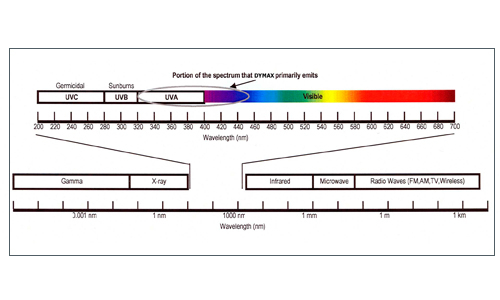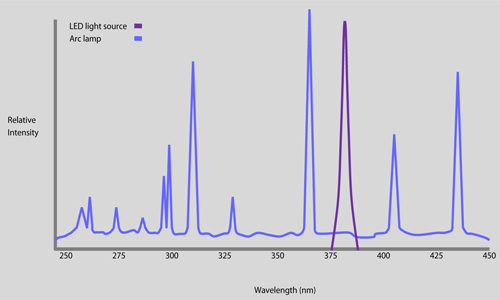LED UV vs. Broad-Spectrum Curing Wavelengths
The electromagnetic spectrum is the collective term for all known frequencies and their linked wavelengths of the known photons (electromagnetic radiation). The spectrum is an extremely wide range of radiation that travels at the speed of light and is divided into different regions based on wavelengths that extend from radio waves (~1 m - 11 km), through visible and UV (~300-800 nm), to gamma rays (~0.001 nm), as shown in Figure 1 below. UV light is the portion of the electromagnetic spectrum between X-Rays and visible light, and the range of shorter wavelengths adjacent to the visible-light spectrum. Visible light is the only portion of the electromagnetic spectrum that the eye can see. Wavelengths in these regions are commonly measured in nanometers (nm). A nanometer is a billionth of a meter or a thousandth of a micron. The UVA range is generally considered the safest of the three UV ranges (UVA, UVB, and UVC).
Broad-Spectrum Curing
Conventional mercury-arc lamps, like the BlueWave® 200 V.3 are considered broadband light sources because they emit light over a wide range of wavelengths including short wave UV, long wave visible, and even longer wave infrared, resulting in multiple energy peaks. Broad-spectrum curing systems utilize high-pressure metal-halide lamps that produce light energy in the 300 to 450 nm range and provide 50-1,000 mW/cm2 of UVA light at the curing surface.
LED Curing
LED (Light-Emitting Diodes) generate curing energy using an array of surface-mounted LEDs instead of traditional metal halide or mercury bulbs. They are semiconductor energy sources that emit very discrete wavelengths of energy, resulting in a single, narrow, bell-shaped emission spectrum. The wavelength distribution from a LED light source, such as the BlueWave® AX-550 V 2.0, can peak in the UV or visible light range, typically at 365, 385, or 405 nm, depending upon the selection of the LED. Figure 2 illustrates the differences in wavelength distribution between an arc lamp and LED light source.
For more information on LED curing, chat with one of our technical specialists.
_________________________________________________________
Enjoying This Content? Let’s Stay Connected.
If you’re finding value in our insights, why not get more of it—delivered right to your inbox? Subscribe to receive the latest technical articles, white papers, product news, and expert tips.


